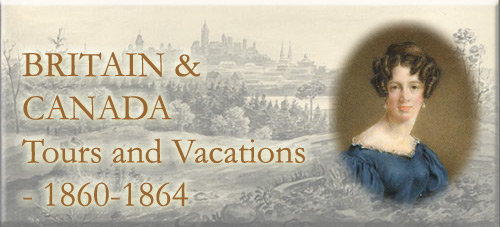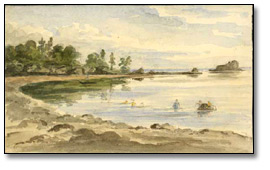
Table of Contents
Home | The Early Years | The Grand Tour | The Grand Tour- Continued
Britain - 1821-1837 | Miniatures on Ivory | Emigration - 1837
Settlement - 1837-1852 | Settlement - Continued | Peterborough and Toronto - 1852-1859
Britain & Canada: Tours and Vacations - 1860-1864 | Britain & Canada -1865-1878
Niagara, Ottawa, and Toronto - 1870s, 1880s
The Final Years | Langton Family and Family Connections | Preserving of the Collection
Resources and Acknowledgements
|
The Langtons resided in Quebec City from 1859-1865. In 1860, however, Anne set out across the Atlantic for another extended visit to Britain. This time she was accompanied by John's and Lydia's eldest daughter, Ellen, who was going to attend Miss Lowe's School for Young Ladies at Southgate, near London - her uncle William having generously offered to pay for her tuition there. This began a pattern for Langton's later years: escorting and chaperoning Canadian nieces and nephews to England and touring with them, often returning to Canada with an English niece or nephew whom she would then introduce to her favourite "Canadian" scenes: more tours, more sketching. In England, Langton now resumed visits to art galleries and other cultural venues. Nearing sixty, she gained a freedom that she had not known in her early or middle adult years. That freedom came to be reflected in her art, with a less literal approach, looser handling of paint, and a wider palette range. This greater ease most likely stemmed from exposure to new styles of art and introductions to the work of new artists at the exhibitions she attended in London and the provinces. |
||
|
|
||
It appears that " the beauties of the [famed] lake country" were the initial inspiration for Langton's maturing artistic development (SOF, 167). As her techniques evolve, she sometimes adopts a more lyrical style as in the sketch of Skiddaw below left where she creates a misty, atmospheric effect. Skiddaw is the highest mountain in the Lake District. It overlooks Derwentwater, below right, which is the most famous of the bodies of water in the Lake District. This part of England was a mecca for artists and writers alike, including John Constable, J. M. W. Turner and the "Romantic" poets, William Wordsworth and Samuel Taylor Coleridge. |
||
Click here to see a larger image (78K ) Skiddaw [mountain] from near the landing, Barrow, North Yorkshire, [186-?] Anne Langton Watercolour Reference Code: F 1077-8-1-9-6 Archives of Ontario, I0008057 |
Click here to see a larger image (81K) Derwentwater [Lake District, Cumbria, England], [ca. 1861] Anne Langton Watercolour Reference Code: F 1077-9-1-18-2 Archives of Ontario, I0008467 |
|
|
|
||
Returning to Canada in the summer of 1862, Langton took the older children to Dalhousie in New Brunswick for a two-month vacation. John and Lydia remained in Quebec City where, in August, Hugh Hornby Langton, their last child, was born. Anne thrived on the outdoor "expeditions" with the children and sketched several sets of miniature landscapes as they played. |
||
| Of this summer, Anne would later write:
|
Click here to see a larger image (103K) Old Woman [Flower Pot] Rock, Dalhousie [New Brunswick], 1862 Anne Langton Watercolour, pen and ink over graphite on cream wove paper Reference Code: F 1077-9-1-9-1 Archives of Ontario, I0008446 |
|
Click here to see a larger image (71K) Dalhousie [New Brunswick], 1862 Anne Langton Watercolour, pen and ink over graphite on cream wove paper Reference Code: F 1077-9-1-8-3 Archives of Ontario, I0008445 |
Click here to see a larger image (67K) Dalhousie [New Brunswick], 1862 Anne Langton Watercolour, pen and ink over graphite on cream wove paper Reference Code: F 1077-9-1-9-2 Archives of Ontario, I0008447 |
|
These diminutive sketches painted at Dalhousie are small gems: crystal-like distillations of coastal scenes. The inclusion of her nephews and nieces enlivens her sketches. Langton worked several versions of this series. |
||
|
|
||
|
|
||
|
|
||
Returning from Dalhousie Langton, ever the avid tourist, made excursions in and around Quebec City. She worked up views, for her English audience, of well-known places or of situations that represented uniquely Canadian scenes. |
||
|
Click here to see a larger image (82K) Falls of Montmorenci [sic], Quebec, [ca. 1864] Anne Langton Watercolour over graphite on cream wove paper Reference Code: F 1077-8-1-2-34 Archives of Ontario, I0008406 |
Click here to see a larger image (59K) At Point Levis, Indian village near Quebec, [ca. 1864] Anne Langton Monochromatic watercolour (sepia toned) with pen and ink over graphite Reference Code: F 1077-9-1-29 Archives of Ontario, I0008419 |
|
The summers of 1864 and '65 were spent in a rented cottage in Point Lévis, across the St. Lawrence River from Quebec. Anne described their life there as "very like the Dalhousie one." She and the children went on rural rambles and the children enjoyed "the supreme delight" of swimming (SOF, 175). In the scene of the Indian village, above right, Langton places herself at a considerable distance from her subjects, perhaps not wishing to intrude too closely on a social grouping to which she does not belong. Unusually for her, she leaves the foreground almost devoid of detail. She employs virtually no "framing" devices such as the low bushes, or side-screening trees that ornament most of her topographical views. The settlement, a small grouping of simple village huts - seen
in the distant middle-ground - is situated at the edge of the river;
a single track winds from the lower left to the centre of the
picture plane. People sit on the ground, lean against the huts,
stand chatting in clusters. Across the river, in the far distance,
the Citadel, the Plains of Abraham and a church spire remind the
viewer of the contrast between the cultural heritage of the Native
inhabitants and that of the white-settler races. |
||
|
|
||
The Early Years | The Grand Tour | The Grand Tour- Continued
Britain - 1821-1837 | Miniatures on Ivory | Emigration - 1837
Settlement - 1837-1852 | Settlement - Continued | Peterborough and Toronto - 1852-1859
Britain & Canada: Tours and Vacations - 1860-1864 | Britain & Canada -1865-1878
Niagara, Ottawa, and Toronto - 1870s, 1880s
The Final Years | Langton Family and Family Connections | Preserving of the Collection
Resources and Acknowledgements
![Skiddaw [mountain] from near the landing, Barrow, North Yorkshire, [186-?]](pics/8057_tours5.jpg)
![Derwentwater [Lake District, Cumbria, England], [ca. 1861]](pics/8467_tours1.jpg)
![Old Woman [Flower Pot] Rock, Dalhousie [New Brunswick], 1862](pics/8446_tours2.jpg)

![Dalhousie [New Brunswick], 1862](pics/8447_tours4.jpg)
![[Natural Arches] Dalhousie [New Brunswick], 1862](pics/8443_tours7.jpg)
![Falls of Montmorenci [sic], Quebec, [ca. 1864]](pics/8406_montmorency_falls.jpg)
![At Point Levis, Indian village near Quebec, [ca. 1864]](pics/8419_point_levis.jpg)